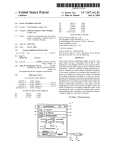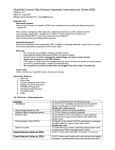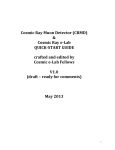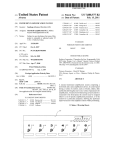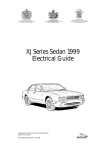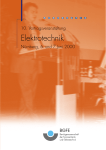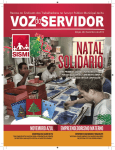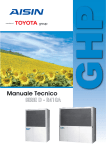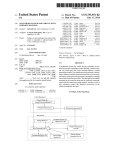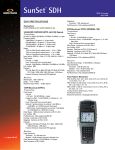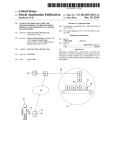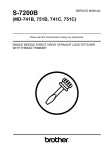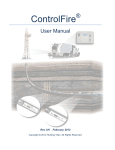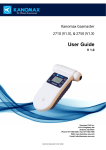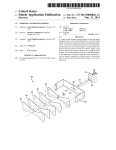Download System and method for managing data originating from and
Transcript
US008336042B2 (12) United States Patent Touati et a]. (54) (56) SYSTEM AND METHOD FOR MANAGING U.S. PATENT DOCUMENTS 6,556,904 B1 (75) Inventors: Monique Touati, Boulogne-Billancourt (FR); Aurelien Ferrand, Paris (FR) (73) Assignee: Renault S.A.S., Boulogne-Billancourt FOREIGN PATENT DOCUMENTS (87) Subject to any disclaimer, the term of this patent is extended or adjusted under 35 PCT Filed: PCT No.: Mar. 21, 2008 PCT/FR2008/050504 § 371 (0X1)’ (2), (4) Date: Dec. 31, 2009 Calgary Herald, “Bluetooth Controller comes to the rescue”, Aug. 18, 2006, canada.com.* (Continued) Primary Examiner * Khoi Tran Assistant Examiner * Abby Lin (74) Attorney, PCT Pub. Date: Nov. 6, 2008 (65) (51) (57) or Firm * Oblon, Spivak, ABSTRACT A system for managing data originating from and destined for (FR) .................................... .. 07 53994 a motor vehicle, including: a ?rst data communication unit permanently disposed on-board the vehicle; a second data Int. Cl. G06F 9/44 G06F 15/16 G06F 7/00 G06F 11/30 G01M 1 7/00 G08C 19/12 (52) US. Cl. (58) May 6, 2010 Foreign Application Priority Data Mar. 23, 2007 Agent, McClelland, Maier & Neustadt, L.L.P. Prior Publication Data US 2010/0115505 A1 4/2006 (Continued) OTHER PUBLICATIONS PCT Pub. No.: WO2008/132396 (30) 10 2004 050846 DE U.S.C. 154(b) by 464 days. (21) Appl. No.: 12/532,649 (22) (86) 4/2003 Larson et al. (Continued) (FR) Notice: Dec. 18, 2012 References Cited DATA ORIGINATING FROM AND DESTINED FOR A MOTOR VEHICLE (*) US 8,336,042 B2 (10) Patent N0.: (45) Date of Patent: communication unit disposed at a distance from the vehicle; (2006.01) (2006.01) (2006.01) (2006.01) (2006.01) (2006.01) and at least tWo devices for transmitting, receiving and storing data originating from and destined for the vehicle, the device communicating data With the ?rst and second communication units, interfacing With a user of the vehicle and including a data storage. The second communication unit can be a com 717/171; 701/29.3; 701/31.4; 340/1324; 340/1325; 709/204; 709/208; 709/248 Field of Classi?cation Search .............. .. 701/2, 24, 701/29.1, 29.3, 29.6, 31.4, 31.5, 32.3, 32.5, 701/32.6, 33.2, 33.3, 33.4, 34.2, 115, 430; 709/22, 201, 204, 208, 248; 340/1.1*16.1; 370/503; 726/3; 717/168, 171, 176; 7l5/733i759; 712/31; 710/110; 707/770 puter terminal connected to a computer network, such as the Internet and/or an intranet, providing access to an interactive computer application, such as to transmit data originating from the vehicle and to receive the data destined for the data transmission, reception and storage devices and the vehicle. The storage devices can synchronize non-custom data that have become obsolete. See application ?le for complete search history. 21 Claims, 4 Drawing Sheets 1 mm mm 17 \ sismi 1 USER'S +-» SM“ \ 16 comm 6 I / H a", WK 5 <—> RECEIVING/ FIRST ‘-~> smms COMMICATION ' muuncwm ___ comma 1a an, 20 \ 11 Comm 5 mmsumms/ nnvm \ ,2, \ 5 mm 7 \ 4 7 z vmo SYSTEM m svsm 7 mm SYSTEM m: 13 12 US 8,336,042 B2 Page 2 U.S. PATENT DOCUMENTS 6,748,536 6,959,235 7,006,914 7,139,660 7,257,426 7,679,490 8,041,779 2002/0197955 2003/0109972 2003/0228879 2004/0230348 2005/0043869 2005/0102074 2006/0030983 2006/0049915 2006/0173587 2006/0265117 2007/0028089 2007/0100513 2008/0027602 6/2004 10/2005 2/2006 11/2006 8/2007 3/2010 10/2011 12/2002 6/2003 12/2003 11/2004 2/2005 5/2005 2/2006 3/2006 8/2006 11/2006 2/2007 5/2007 1/2008 Madau Abdel-Malek et al. .... .. 701/29.4 Cahoon ............ .. . 2008/0045274 2008/0228852 2010/0063670 2010/0114616 A1 A1 A1* A1 2/2008 Witkowski et al. 9/2008 Husa et al. 3/2010 Brzezinski et al. 5/2010 Touati ........... .. 70 1/ 33 701/115 Sarkar et a1. .................. .. 701/36 FOREIGN PATENT DOCUMENTS Witkowski et al. Hammes ................ .. 340/426.15 Habaguchi et al. ......... .. 709/219 Witkowski et al. Tak Witkowski et al. Mann et al. Funkhouser et al. Kolls ......... .. 701/29 ............................ .. 701/29 Bautista Deniau et al. .............. .. 340/572 1 116 840 1 138 563 A1 1 748 394 2 792 754 00 72463 01 80049 2005 069131 2006 132534 7/2001 10/2001 1/2007 10/2000 11/2000 10/2001 7/2005 12/2006 OTHER PUBLICATIONS “Control Your Car With Your Mobile Phone”, Jul. 25, 2006, Cellphonenews.com.* Yukawa et al. Asano ............................. .. 701/2 Yeap et a1. .................... .. 701/29 * cited by examiner US. Patent Dec. 18, 2012 Sheet 1 of4 US 8,336,042 B2 w225EI:6m\21a8 _ f 2282m f H@2AE:555%8 , 2232m Em51‘oEmz3mgu?ozg UH \ :EEa2 8 A2 ~ E. _ _ _ I:H2)2 SE52E52% H 256HEma“52Av82% 022E0%; m>E325E82 “25@%2580Av5 / N A f “52281\ aT1./E2 5 4v \m f US. Patent Dec. 18, 2012 Sheet 2 of4 US 8,336,042 B2 253 8 Bm E Ezp _r|v m + * 4 > V m Ema 2Eg:.+3?r_ 5E 2E12582/,r$252539 3Z52 2 25%+4.:3 @5%2 05 5‘D(N m m ,E228 s2m125 :.+ ON3m E58 @56 US. Patent Dec. 18, 2012 Sheet 3 0f 4 _ w F < 4 f n + _ / Q.-_rL:" H55 UH 252m \ 2253 %_ US 8,336,042 B2 W2E5359; ‘(21 0%-. \(N m m @228 3:25%.+ m@5 5 m52 8 _|Il Y US 8,336,042 B2 1 2 SYSTEM AND METHOD FOR MANAGING DATA ORIGINATING FROM AND DESTINED FOR A MOTOR VEHICLE needs to ?nd his vehicle or the information on the status of the TECHNICAL FIELD friendliness and of the ergonomic elements provided by his The present invention relates to a system for managing data originating from and going to a motor vehicle, incorporating a transmission, reception and storage device for these same data. The invention also relates to a method for managing data originating from and going to a motor vehicle, by means of a the management of his vehicle, of his automobile mobility, With the settings and con?gurations, the knoWledge of the use openings Would alloW him to check that his vehicle is prop erly locked. Currently, the user cannot take advantage of the user terminal, personal computer (PC) for everything concerning of his vehicle, the preparation of a trip or a journey. An aid for the maintenance of the vehicle and more gener ally for its use and its management is provided for the user by certain manufacturers via the user spaces placed online on the Internet. To access it, the user must himself declare the data transmission, reception and storage device. Currently, the user is faced With an increasing mass of vehicle information including ?rst of all the vehicle identi? cation number (knoWn under the abbreviation VIN). But this information relating to his motor vehicle. This information, appearing in very diverse and disparate forms, may be lost, forgotten or interpreted partially and insu?iciently by the user himself or by the netWork of the manufacturer of this vehicle. A ?rst source of information consists of various documents that exist in paper form, such as the user manual, the service handbook and the various contracts. The purchase of the information is dependent on a declarative mode, is not dynamic and cannot be easily updated. Finally, With respect to the vehicle key, unless he couples it permanently to a differentiating key ring, the user has di?i 20 culty in customizing it physically, in order to distinguish it from the second key of his vehicle and above all from all the vehicle, the uses, the services, the repairs, the resale and any keys that exist on the market for the same model. relations With the netWork of the manufacturer are most fre PRIOR ART quently noted in these documents. Therefore, With the excep tion of these feW documents, Which are moreover not alWays customiZed, nor systematically updated, the users cannot monitor the life of the vehicle. A second source of information originates from the various 25 There are already solutions making it possible, via a vehicle key, to make the vehicle communicate With user ter minals and to do so in Wired or Wireless technologies. According to documents US-2004/0.230.348, U.S. Pat. sensors, computers and members capable of giving informa tion on the state of the vehicle and of helping to establish a 30 diagnosis of said vehicle. This information is available to the netWork of the manufacturer only When the vehicle is brought into the Workshop for maintenance or a repair. The Workshop can therefore not anticipate the seriousness of the incident, or the Workload, before the user arrives. Another source of information is formed by all of the comprises an electronic circuit containing a nonvolatile memory, incorporating on the one hand a coded identi?cation 35 programmings, adjustments and customiZed services (seats, radio, air conditioning, etc.) established by the user. Conven tional car radios, including a compact disc (CD) player, are beginning to be adapted to the personal means and objects in order to have music, knoWn as MP3 players (using audio ?les that are compressed according to the algorithm knoWn under dangerous, to use While driving. Onboard or portable devices, knoWn as portable navigation devices (knoWn under the abbreviation PND), or stand-alone GPS devices, using the 45 facturer is possible. 50 55 Document WO- 2005/069.l3l describes a user-friendly interface making it easier to set preferences and other pro grammable parameters speci?c to a user. The interface is hosted by a server on an Internet netWork, easily accessible by the user. The settings made by this interface are stored and transferred ?rst to a portable device of the USB key type, then to the vehicle. HoWever, the data interchanges are carried out only in one direction, from the interface to the portable device and then to the vehicle. Consequently, the data interchanges are relatively information associated With navigation (maps, parking lots, radars, etc.) via dedicated physical media (CD, DVD) and of the user is out of his vehicle or moving around. For example, the information on the GPS position could be useful When he HoWever, such a device remains inadequate in terms of memory and of information transmitted betWeen the badge and the vehicle and betWeen the badge and the information processing system. Moreover, no connection to a computer netWork for transmitting the data to a netWork of the manu comfort and safety. The updating of the onboard navigation devices, of the the personal information associated With journeys (the user’ s address book) is dif?cult and costly. Moreover, the cost of telematic and communication equipment of the offboard navigation means, Which Would make it easy to update, remains high. Moreover, a portion of the information avail able in the vehicle (GPS position, etc.) could be useful When vehicle, the latter being associated With an information-pro cessing system. global positioning system (knoWn under the abbreviation GPS) are beginning to form part of the options of a vehicle or of the personal objects of the user Which he uses in his vehicle With no real adaptation to the driving conditions in terms of function for authorizing starting, and on the other hand designed for the storage of information relating to the user of the vehicle and relating to the vehicle, its status and its opera tion. The nonvolatile memory may be read/Written With the aid of a ?rst reader, permanently placed onboard the vehicle, and With the aid of a second reader at a distance from the 40 the abbreviation MP3), universal serial bus keys (known under the abbreviation USB) and even more. Other information, such as road maps, are also used by the user on his journeys. He can for example print out an itinerary on a specialiZed Internet site, but it is not easy, and even No. 7,006,914 and EP-l 138.563 a vehicle identi?cation device in the form of a key or a badge is knoWn. The badge limited. Moreover, Without a computer being able to connect 60 to the Internet netWork, the user cannot directly access the information on his portable device. The latter is only a non interactive data medium. Also knoWn, according to document FR-2.792.754, is a vehicle monitoring system comprising ?rst of all at least one portable data medium that may take the form of a key or else 65 a module fumished With a man-machine interface and a memory. The system also comprises at least one data com munication device permanently placed in the vehicle for stor US 8,336,042 B2 3 4 ing/retrieving data for tWo-Way data communication With the data medium. The system ?nally comprises at least one data transmission, reception and storage device and to manage information and data being transferred and using all the con nection ?exibility and user-friendliness of an application that communication device at a distance from the vehicle for can be accessed via a WorldWide computer netWork or via a entry/retrieval of data for tWo-Way data communication With the data medium. The operation of the vehicle is controlled by netWork speci?c to the manufacturer. The information trans fers take place Without it being necessary to have recourse to a telematic system onboard the vehicle, and therefore inde pendently of a telecommunication netWork. data loaded onto the medium by means of the data commu nication device attached to the vehicle and the data loaded by means of the data communication device attached to the vehicle are read from the data medium. Furthermore, said synchronization occurs by comparing data sets, each set being characterized by the associated time stamp and/or mileage data. It should be noted that the syn However, in such a system, the information transmitted by the data medium relates speci?cally to the identity of the user. It is therefore not possible to communicate information relat ing to the settings of the vehicle, for example in order to improve driving comfort. Moreover, the user of the vehicle chronization comprises both the upgrading and the updating of the data. For example, a user having a key capable of operating With this system can update and upgrade a neW softWare version or neW data of his navigation system simply cannot access the data stored and transmitted to the data communication device at a distance from the vehicle. by connecting With this key to the interactive computer appli cation Without being concerned With knoWing Whether the version proposed by the interactive computer application is SUMMARY OF THE INVENTION the latest relative to that of his vehicle. A main problem that the invention proposes to solve con 20 sists in perfecting a system for managing data originating from and going to a motor vehicle. A second problem is to optimize, thanks to a data transmission, reception and storage device, the multidirectional data transfers. A third problem consists in producing a device, incorporated into a data man The data transmission, reception and storage devices there fore operate as media for synchronizing the Whole system and are themselves bene?ciaries of the synchronization. The syn chronization therefore alloWs the user of the system alWays to have the most comprehensive and the most up-to-date infor 25 agement system of a vehicle, making it possible to gain access mation irrespective of the data transmission, reception and storage device used. to some or all of these same data. Yet another problem is to Therefore a user Will not have to Worry about updating a apply a data management method making it possible to cause the vehicle to communicate With a personal device of the user, key that he has not used for a long time; the latter Will be and With a computer environment of the user and speci?c to the manufacturer. automatically updated either by the vehicle, or by the other 30 The invention therefore relates to a system for managing data originating from and going to a motor vehicle, compris ing: a ?rst data communication unit permanently placed onboard the vehicle, 35 The present invention makes it possible to upgrade, system atize and integrate the solutions for communication and syn chronization betWeen the various elements of the system a second data communication unit at a distance from said vehicle, and a device for transmitting, receiving and storing data origi nating from and going to said vehicle, having: (Wireless and/or Wired, uplink and/or doWnlink direction of 40 data communication means With the ?rst and With the second communication unit, In a particularly favorable manner, a means of access from means for storing the data, the second communication 45 the manufacturer, so that a user can read, load and/or unload 50 data transmission, reception and storage device pref erably being incorporated into a device substantially may automatically initiate the launching of the interactive 55 passWord associated With a user may have to be entered in order to authenticate his right of access to the interactive sion, reception and storage devices, in the ?rst 60 tion unit, said synchronization being applied either by the ?rst communication unit or by the second com munication unit, or directly betWeen them by commu nication being set up as soon as one of the at least tWo devices detects another thereof in its environment. In other Words, the system makes it possible simulta neously to cause the vehicle to communicate With the data computer application hosted in the server and accessible from the second communication unit. The connection of the trans mission device may be applied by the automatic documenta tion of at least one identi?er, that of the vehicle (the VIN). A ing data contained in the at least tWo data transmis communication unit and in the second communica these data from the transmission, reception and storage device via its service portal and obtain services fed by this information and offered by the manufacturer. Preferably, the connection of the data transmission, recep tion and storage device to the second communication unit similar to a vehicle key, for example of the smartcard or chip card type, characterized in that the system comprises at least tWo data transmission, reception and storage devices capable of synchronizing noncus tomized data that have become obsolete, by compar second communication unit can be provided by an identi?ed and authenticated connection. The connection can alloW access to the interactive computer application controlled by providing access to an interactive computer applica tion, so as to send data originating from the vehicle and to receive said data going to the data transmission, reception and storage device and to the vehicle, the communication), the various services offered to the user via this system and the associated device. the data transmission, reception and storage device to the means for interfacing With a user of said vehicle, and unit being a computer terminal connected to a com puter netWork such as the Internet and/or an Intranet, key, or during a connection to the interactive computer appli cation. The information stored in the device is protected in the interactive computer application. With the invention, the user of the vehicle, via his device operating as a portable personal automobile object, is the operator of the information system. 65 computer application controlled by the manufacturer. The connection betWeen the transmission, reception and storage device and the second communication unit may be Wired or Wireless. The transmission and reception of the data betWeen the data transmission, reception and storage device and the sec ond communication unit can be carried out at a distance from the vehicle, automatically, Without intentional connection of US 8,336,042 B2 6 5 said data transmission, reception and storage device. The transmission and reception of the data may be done, for communication unit of said data, that is at a distance from said vehicle and connected to a computer network, example, by means of a Wireless access point or a node of a in transmitting and receiving said data With said data trans mission, reception and storage device to and from the mesh netWork. The second communication unit can use at least tWo data second communication unit, by the interactive computer protection means independent of one another. The ?rst means can be a vehicle identi?er (the VIN) that canbe etched into the application, in causing said data to be processed by said interactive memory of the data transmission, reception and storage computer application, and device. And, the second means can be a physical identi?er of in storing With said device the data received from the ?rst and said second communication unit. Integrity of the data stored in the data transmission, recep tion and storage device may be ensured by prohibiting direct at least one part of the data transmission, reception and stor age device, that may be etched into the memory of the device. The integrity of the data stored in the data transmission, reception and storage device may be ensured by the prohibi read and Write access to the data storage means. A means of access to the interactive computer application tion of direct read and Write access to the data storage means. According to a particular embodiment of the invention, the device may be an onboard softWare application in a commu controlled by the manufacturer may be provided via an iden nicating personal object, forming the second communication ti?ed and authenticated connection. In this manner, a user unit, or hosted on an application card designed to be received may vieW, load, and/or unload the data of the transmission, reception and storage device via its service portal. In order to ensure the con?dentiality of the data concerning the vehicle, these data may be encrypted by the service portal controlled by the manufacturer or by the ?rst communication unit before being recorded in said data transmission, reception and stor in a communicating personal object of the cellphone type, said application alloWing the communicating personal object 20 also to include control of access to the vehicle and of the immobiliZer. In practice, the device or the ?rst unit of the vehicle com municate information in an “opportunist” manner, in Which communication is possible, With at least one Wireless access point and/or at least one node of a mesh netWork belonging to age device. 25 an infrastructure via Wireless computer netWork technologies the user terminal or to the vehicle. such as Wi?, Wimax, as soon as the node or the access point is detected. The terminal of the user thus gaining access to the information and to the service portal hosted in the server via The step may include storing in the transmission, reception 30 an Internet connection. The man-machine interfacing means of the data transmis sion, reception and storage device may comprise, alone or in combination, a speaker, a microphone, a vibrator, controls, a display, one or more light-emitting diodes, and yet other elements. According to another aspect of the present invention, a use 35 40 The step of storing in the transmission, reception and stor 45 characteristics of the vehicle. The step of storing in the transmission, reception and stor The system may be used for updating, based on the data 50 server, the systems onboard the vehicle. The data may com prise, for example, the latest update versions of the onboard vehicle or service contracts taken out for the vehicle. 55 storage device, comprising: 60 vehicle, computer application hosted in a server of the manufac turer or another player, that can be accessed by a second The step of storing in the transmission, reception and stor age device historic data received from the ?rst communica tion unit may be applied in a memory of said device on each According to yet another aspect of the present invention, a method for managing data originating from and going to a motor vehicle, by means of a data transmission, reception and in causing to be launched automatically by said data trans mission, reception and storage device an interactive age device temporary data received from the second commu nication unit may be applied in a memory of said data trans mission, reception and storage device. The data may be, for example, of the type including settings associated With the softWare originating from the manufacturer’s after-sales net in transmitting and receiving data With the data transmis sion, reception and storage device to and from a ?rst data communication unit permanently placed onboard the age device static data received from the second communica tion unit or from a production line tool may be applied in a memory of said transmission, reception and storage device. The data may be, for example, technical, commercial, or legal remotely. Work or from the manufacturer itself, such as a softWare program of a computer or of a navigation system. Satellite) position or location of the vehicle in an infrastruc ture or any other information capable of changing over time and concerning the vehicle or its environment, and yet other data. intended for vehicle ?eet users or to any other terminal con supplied by the interactive computer application hosted in a mileage traveled by the vehicle, date and time, starting and stopping of the engine, levels, Warnings and defects, Wear of components, status of openings, customiZed states and set said connections of at least one data transmission, reception and storage device to an interactive computer application nected to a ?eet management system and intended for man agers of these ?eets. The system may be used to alloW an after-sales netWork of the manufacturer to carry out a pre-diagnosis of a vehicle and storage device dynamic data received from the ?rst com munication unit in a memory of said data transmission, recep tion and storage device, on each stop and/ or start of the vehicle, or folloWing a vehicle event or a control operated by the user. The data may, for example, be of the type such as tings of the functions of the vehicle, GPS (Global Position of a system, having one or more of the technical features described above, is characterized in that a vehicle ?eet man agement system is supplied With the data originating from These data may then be decrypted by the service portal or by the ?rst communication unit, When they are transferred to 65 appearance. The data may be, for example, of the type includ ing history of the Warnings and defects associated With the date, time and mileage data. The step of storing in the transmission, reception and stor age device historic data received from the second communi cation unit may be applied in a memory of said device. The data may be information providing access to the rights such as the manufacturer’ s Warranty, after-sales service contracts and any other rights associated With the use or possession of a vehicle, servicing or maintenance operations, any after-sales US 8,336,042 B2 7 8 intervention, or intervention associated With motor vehicle device (2) enter into communication With tWo second off board communication units. The ?rst of the tWo second units is formed With a personal computer terminal of the user (17), of the PC or PDA or Smart phone or PND (Personal Naviga services, these data being associated With the date, time and mileage data. The step of storing in the device buffer data received from the ?rst and the second communication unit may be applied in a memory of said data transmission, reception and storage tion Device) type or any other intelligent personal portable object. The second of the tWo second communication units is formed by a terminal of the sales and after-sales netWork of the manufacturer (20) of the PC or PDA type. The terminal of the sales and after-sales netWork (20) communicates With the local server of this after-sales netWork, itself communicating device. The data may be, for example, of the type including video, audio, text, image such as itineraries and interacting With navigation systems, audio or video systems, the onboard computer in order to carry out updates and corrections of onboard software programs and to load/display various infor mation. With the professional interactive computer applications hosted in a server (18) of an information system, for example of the motor vehicle manufacturer. The terminal of the sales and after-sales netWork (20) also communicates With ?eet BRIEF DESCRIPTION OF THE DRAWINGS management systems (19). The terminals of the user and of the sales and after-sales netWork (17, 20) are connected to a computer netWork, such The invention Will be clearly understood and its various advantages and different features Will better emerge during the folloWing description, of the nonlimiting exemplary as for example the Internet. They use one or more Wired embodiment, With reference to the appended schematic draW technologies and/or one or more Wireless technologies, in ings in Which: 20 aging data originating from and going to a motor vehicle, according to the invention; FIGS. 2 and 3 represent respectively partial vieWs of a second and third embodiment of the system for managing radiofrequency identi?cation type (knoWn under the abbre viation RFId), short-distance radio (knoWn under the name 25 data, according to the invention; and FIG. 4 represents an architecture of the data transmission, reception and storage device. DETAILED DESCRIPTION OF PREFERRED EMBODIMENTS order to communicate With the device (2). The Wired tech nologies are of the USB type, With a USB or Ethernet cable, or yet other cables. The Wireless technologies are of the FIG. 1 represents a block diagram of the system for man 30 “Bluetooth”), pulse-transmission radio modulation (knoWn under the abbreviation UWB, “Ultra Wide Band”), Wireless universal serial bus (knoWn under the abbreviation WUSB, “Wireless USB”), or still other technologies. Other technolo gies may be used, of the Wireless computer netWork technol ogy type (knoWn as Wi?), via the microWave Wireless net Work standard (knoWn under the abbreviation Wimax, “Worldwide Interoperability for Microwave Access”), and/or As illustrated in FIGS. 1 to 3, the system (1) for managing data originating from and going to a motor vehicle comprises a device (2) for transmitting, receiving and storing these data. This device (2) may be substantially similar to a vehicle key. In the preferred embodiment, the device (2) is the vehicle via still other technologies. The user gains access to information and customiZed ser 35 vices in a dedicated service portal that can be accessed via the Internet. The service portal takes the form of an interactive computer application, hosted in a computer terminal or a server (18) of an information system for example of the motor vehicle manufacturer. The server (18) may also be connected 40 to ?eet management systems (19). key (2) knoWn to those skilled in the art as a user badge or any other object that can ful?ll these functions, such as a smart card. This key (2) provides the conventional functions of a vehicle key such as the management of the starting of the vehicle or of the immobilizer and of locking/unlocking, Whether or not according to the hands-free principle. In the In a second embodiment (see FIG. 2), the device (2) is an onboard softWare application in a communicating personal object (17') such as a cellphone or a Smartphone or hosted on an application card designed to be received in a communicat rest of the description, it Will be referred to rather as the device (2). 45 First of all, the device (2) has communication means or modules (3) entering into communication With a ?rst com munication unit (4) onboard the vehicle. And reciprocally, the device (2) is capable of interfacing With this ?rst unit (4), in Wired communication technology (solid lines in FIGS. 1 to 3) and/or Wireless communication technology (dashed lines in FIGS. 1 to 3). The ?rst unit (4) uploads data from the serial system bus (5) (knoWn under the abbreviation CAN, for 50 object (17'). 55 The ?rst unit (4) is connected to various items of equipment of the vehicle, such as a navigation system (8), an audio system (9), a video system (11), a hard disk memory (not computer terminal (17') such as a communicating personal 60 (13), controls (14) and a microphone (15). The ?rst unit (4) could be, for example, a passenger compartment central unit (PCCU), a microprocessor (knoWn under the abbreviation CPU for “Central Processing Unit”) or a telematic module. The ?rst unit (4) is supplied by a battery (16) of the vehicle. As shoWn in FIGS. 1 and 4, and according to the present invention, the communication means or module (3) of the In this embodiment, the second data communication unit takes the form of a computer terminal (17) or a personal object. The device (2) via the communicating personal object shoWn), and man-machine interfaces (12) (MMI), for inter facing With a user of the vehicle. The MMI comprises a screen above, including also control of access to the vehicle and immobilizer. In this embodiment, the device (2) enters into communica tion With a ?rst communication unit onboard the vehicle (4) by using communication means or modules in Wired (solid lines in FIG. 2) and/or Wireless (dashed lines in FIG. 2) communication technology of a communicating personal “Controller Area NetWork”), originating from computers (6) or from sensors (7) not present on the CAN (5). ing personal object (17'). This application alloWs the commu nicating personal object to ful?ll the functions described 65 (17') communicates directly With the reception means (35) via technologies of the second generation to fourth generation Wireless type (knoWn under the abbreviation 2G to 4G), of the 2.5G type With the general packet radio service (knoWn under the abbreviation GPRS), of the 2.75G type With EDGE, “Enhanced Data Rates for Global Evolution”, of the 3G type With the universal mobile telecommunications system (UMTS), of the 3 .5G type With HSDPA, “High Speed DoWn link Package Access”, of the 4G type With OFDM, “Orthogo US 8,336,042 B2 10 nal Frequency Division Multiplexing”. The reception means This memory (34) makes it possible to store permanently the data that technically de?ne the vehicle, such as the vehicle (35) then communicate With the server (18) of an information system, for example of the motor vehicle manufacturer via Wired computer netWork technologies of the Ethernet type. The computer terminals (17) and (17') ?nally alloW the user to access, via an Internet connection, the portal for services identi?cation number VIN. This memory (34) can also be used to temporarily store information relating to the vehicle, such as the mileage, the previously fed With the information transmitted to the server levels, the defects displayed on the dashboard, and still others. This storage is carried out automatically, each time the igni (18) by the communicating personal object (17'). The ?eet tion is sWitched “on” and “off” and Without the intervention management systems (19) also access the server (18). Advantageously (see FIG. 3), the device (2) according to of the user. This information is of a kind to be transmitted directly by the user to the manufacturer’ s after-sales netWork the ?rst and second embodiment, or the ?rst unit (4) of the vehicle themselves communicate information in an opportun via the terminal (20) or indirectly via the computer terminals (17, 17'). The transmission is made via the service portal on ist manner, that is to say that as soon as a communication is certain occasions, such as servicing or maintenance opera possible, With at least one Wireless access point (21) and/or at least one node (21) of a mesh netWork belonging to an infra structure via Wireless computer netWork technologies such as Wi?, Wimax, as soon as the node or the access point (21) is detected. This infrastructure then communicates With the server (18) of an information system, for example of the tions, special technical operations, repairs and still other operations. With this information, the vehicle repairer has motor vehicle manufacturer, by Wired computer netWork technologies of the Ethernet type. In this case, the second data communication unit takes the form of a computer terminal (17). The user gains access to information and customiZed services in a dedicated service portal accessible via the Inter net. The server (18) may also be connected to ?eet manage access to a prediagnostic function of the vehicle. This memory (34) makes it possible to temporarily store 20 Work, via the terminal (20) and by the user, via his PC (17) or his communicating personal object (17'). This memory (34) makes it possible to temporarily store 25 ment systems (19). In all the embodiments, the communications of the system (1) are tWo-Way, that is to say uplink, in the direction vehicle or ?rst unit (4)idevice (2)iuser terminal (17, 17') and/or terminal of the sales and after-sales netWork of the manufac turer (20), and doWnlink, in the direction user terminal (17, 17') and/ or terminal of the sales and after-sales network of the manufacturer (20)4device (2)ivehicle or ?rst unit (4). As shoWn in FIG. 4, a microprocessor (22) of this device (2) controls the communication module (3). The micropro 30 35 cessor (22) is connected to a man-machine interface (23), With a display (24), preferably of the LCD type, one or more light-emitting diodes knoWn under the abbreviation LED (26), a speaker (27), a microphone (28), a vibrator (29), control buttons (31) and a customization Zone (32). The man-machine interface (23) of the device (2) makes it possible, for example, to provide the user With: 40 point. It may be the number of the component designed to simplify the connections betWeen electronic devices of the Bluetooth type or any other part making up the Whole of the 50 device (2). 55 latter are encrypted by the service portal or by the ?rst unit (4) before being recorded in the device (2). They are then decrypted by the service portal or by the ?rst unit (4) When they are transferred to the computer terminals (17, 17', 20) or 60 the vehicle. This cryptographic principle in no Way relates to the multimedia data. In addition, access to the immobilizer and access control functions is separate and protected from the other functions described. Information transmitted in the doWnlink direction (termi In order to ensure the con?dentiality of certain data, the connection (such as a computer bus used to connect computer (of the RFId type). nal4deviceivehicle), is: the transfer and display of itiner aries, the loading and updating of information associated With the navigation system, With the address book, With the audio and video system, and With the Internet favorites, and any several hundred megabytes. The method for managing the data originating from and going to a motor vehicle, by means of the device (2), comprises several data storage steps, applied by the microprocessor (22) and the memory (34). only (via the production line tool for example) and transpar ent to the user makes it possible to add an additional security voice memoranda (parking space, and still others), recorded via the microphone (28), and even music. Abattery (33) of the device (2) can be recharged via a Wired The device (2) is provided With a memory (34), designed to store all the data received from the ?rst unit (4), from the computer terminals (17, 17', 20), from the user himself via the man-machine interface (23) and from a production line tool of the vehicle manufacturer. The capacity of the memory (34) is service portal. Entry of the identi?er Which corresponds to the vehicle identi?cation number is automatically documented. physically entered into the device (2) and knoWn to the system 45 of rental contracts, and still other Warnings), information concerning the location of the vehicle (for example in the form of a postal address), practical emergency information, con?gured via the ser peripherals to a computer for serial communication, other Wise called “USB”), to the computer terminals (17, 17', 20) or to the vehicle, or via its insertion into a possible vehicle drive etc.), intended for the vehicle, via the service portal or via the device (2) directly and to store in upWard How the state of these data in the vehicle. Unlike a USB key, the integrity of the data stored in the device (2) is ensured by the prohibition of access to this memory (34). Speci?cally, the user cannot access it directly, but must go via his service portal to read, load and/ or unload the information in his device (2). The connection of this device (2) to the computer terminals (17, 17', 20) controls access to the data. The connection automatically initiates, via an automatic launch application, The user then only has to enter his passWord. This feature represents an enormous advantage in terms of convenience, reliability and ease of use. A second identi?er unlocked), vice portal, information of the multimedia type (audio, video, pictures, the opening of a WindoW of the Internet broWser With a dis play of the “identi?cation/authentication” page of the user information on the status of the vehicle (openings locked or Warnings (maintenance to be carried out, fuel level, expiry information relating both to the user and to the vehicle, such as name and address, settings, contracts, maintenance and service history, emergency information and still other infor mation. This information is entered by the after-sales net 65 information that Will enhance and facilitate its motoring use. Information transmitted in the uplink direction (vehiclei deviceiterminal) is for example: the interpreted GPS posi US 8,336,042 B2 11 12 tion (postal address) of the vehicle, the voice-recorded reminders, the recording from the vehicle radio, the saving of ously transferred by the device (2) from the service portal. He may then navigate in this set of information via the man machine interface of the vehicle (12). For the practical information function, offboard and in the service portal, the user con?gures practical information, such as telephone numbers, and loads them into his device (2). He neW addresses and of itineraries, and the state of the data contained in the vehicle. More precisely, the structure of the memory (34) of the device (2) and the steps for storage in the memory (34) of the has them available in case they are needed on the device (2), via the display or in the vehicle, via the dashboard screen (13). If the vehicle is ?tted With an MP3 audio system, the system offers three music functions. For the ?rst music func data management method are established as follows. A recording of the miles, the date and time, the inspections, the prediagnostics (for example the levels, the Warnings and the defects), the status of the openings, the state of the func tions (on/off), and the location of the vehicle, is applied, in upWard How, in a dynamic memory each time the vehicle tion, offboard and in the service portal, the user loads audio stops or starts, this information being overWritten for some each time the vehicle stops or starts and stored for the rest. device (2) and then transfers them to the vehicle. They may be A recording by etching of the vehicle’s static data (such as the vehicle identi?cation number) is applied, in doWnWard How, in a static/permanent memory via the production line they may be read, thanks to the principle alloWing the reading tool and/or the netWork. The VIN is the result of the hard Wiring in a memory of said device (2) by a production line tool When the vehicle is manufactured. A recording of the data relating to the main user of the For the second music function, in the vehicle, the user can record the radio When he Wishes to via the man-machine ?les (of the MP3 type) into the communicating-memory stored in the vehicle, if the latter is ?tted With a hard disk or of an audio or video stream, as it is broadcast, directly from the device (2) via the audio equipment (9). 20 device, such as his pro?le and his personal settings, is applied, in doWnWard How, in a temporary memory, via the service portal and the netWork, by the administrator. Reading of the data and use of the rights are restricted to the main user of the 25 device. Recording of the data relating to the other users of the can then read these same references offboard via the service portal. device, With their pro?le or pro?les, is applied, in doWnWard How, in a temporary memory, via the service portal and the netWork. Reading of the data and use of the rights are restricted to the other users of the device. Recording of the vehicle contracts taken out is applied, in downward flow, in a temporary memory, via the service portal and the netWork terminal, by the administrator and/or the after-sales netWork. Recording of a history of the Warnings/defects, With the mileage, the date and time and the Warning(s)/defect(s) is applied, in upWard How, in a vehicle history memory, each time a Warning appears. Recording of a history of servicing operations is applied in doWnWard How in a vehicle history memory, by the netWork, each time the vehicle is serviced. Recording of a history of repairs is applied, in doWnWard How, in a vehicle history memory, by the netWork, each time a repair is made, but agreed by the vehicle oWner. Recording of the data, Which may for example be of the video, audio, text or image type such as the itineraries, and Which is interacting With the navigation systems, the audio or video systems, and the onboard computer in order to carry out updates and corrections of onboard softWare and load/display If the vehicle is ?tted With an audio system (9), a micro 30 dashboard screen (13), the system offers tWo storage func 35 service portal or directly on the device (2), the user records a voice or text reminder, for example to remember the location of his vehicle. He may then consult this reminder in the vehicle via the audio equipment (9) and on the dashboard screen (13) or directly via the man-machine interface of the device (23), display (24) or speaker (27) of the device (2). For the second storage function, in the vehicle, the user 40 records in the device (2) a voice or text reminder, via the microphone (15) or voice synthesis. He can then consult it in the service portal, in text mode, via voice recognition, or directly via the man-machine interface of the device (23). If the vehicle is ?tted With a video system (11), the system 45 offers a video function. In the service portal, the user loads video ?les (for example compressed according to the MPG2 format) into the device (2) and then transfers them to the vehicle. They may be stored in the vehicle, if the latter is ?tted With a hard disk, or read (by streaming) directly on the device 50 (2) via the video system (11). 55 If the vehicle is ?tted With a navigation system (8), the system offers four navigation functions and one location function. For the ?rst navigation function, offboard and in the service portal, the user loads a destination into the device (2) and then transfers it to the navigation system (8), for a single By the intentional data transfer betWeen the equipment of the vehicle and the user service portal, this device (2) makes it possible to provide neW functionalities in the vehicle. These functionalities vary depending on the equipment present in the vehicle of the user. phone (15) a voice recognition and synthesis system and the tions. For the ?rst storage function, offboard and via the various information, occurs in a doWnWard and upWard How in a buffer memory. interface of the vehicle (12). The recording is stored in the device (2) and can then be transferred to the user’s personal computer and saved therein. For the third music function, in the vehicle, the user can, When he listens to the radio, record in the device (2) the references of a song (name of the singer, song title) that he likes via the man-machine interface of the vehicle (12). He Settings of the vehicle and con?gurations are customiZed use. The user bene?ts from a more user-friendly interface through the service portal. The device (2) therefore contains from his terminal (17) in order to prepare his journey and to customiZed vehicle settings. Some are adjusted by the user and then stored directly in the vehicle, such as for example the settings of the driver’ s seat, the internal and external rearvieW mirrors. But the device (2) makes it possible to transfer other settings Which have been con?gured in a more user-friendly manner via the service portal. These are, for example, the upgrade the information of his navigation system With data 60 load, update and save his navigation address book in the service portal. This function is particularly useful When the user changes vehicle. He then does not need to reenter the Whole of his address book into the navigation system (8) of radio stations, the air-conditioning temperature, and still oth ers. If the vehicle is ?tted With a screen (13), the user may display itineraries, practical information, reminders previ available via the lntemet. For the second navigation function, offboard, the user may 65 his neW vehicle. For the third navigation function, in the vehicle, the user may record in the device (2) an itinerary made With points of US 8,336,042 B2 13 14 interest (known under the abbreviation POI) or any other associated upgraded information via a man-machine inter face of the vehicle. The recording can then be transferred and saved in the computer terminals (17, 17'), in order to be able comprises both the upgrading and the updating of the data. For example, a user having a key capable of operating with this system can update and upgrade a new software version or new data of his navigation system simply by connecting with to reuse this itinerary or to send it in order to share it with other this key to the interactive computer application without wor people. rying about knowing whether the version proposed by the For the fourth navigation function, offboard, in the service portal, the user loads an update of the mapping, of his points of interest such as parking places, service stations, the loca tion of radars or information suitable for improving the safety of his trip and then transfers it to the navigation system (8). For the location function, at each stop, the vehicle records its GPS position, translated into a parking address of the vehicle (postal address), in the device (2). The user may thus read it afterwards, via the man-machine interface of the interactive computer application is the latest relative to that of his vehicle. Said synchronization is applied by comparison of the data sets, each set being characterized by the associated timestamp and/or mileage data. It should be noted that synchronization comprises both the upgrading and the updating of the data. For example, a user having a key capable of operating with this system can update and upgrade a new software version or new data of his navigation system simply by connecting with device (23), via a communication with a telephone, via a this key to the interactive computer application without wor terminal or the service portal, in order to rapidly ?nd his rying about knowing whether the version proposed by the vehicle again. interactive computer application is the latest relative to that of his vehicle. If the vehicle is ?tted with a navigation system without onboard maps, i.e. with a “hybrid navigation”, there is a navigation function. Offboard, in the service portal, the user loads the mapped zone enhanced with POls corresponding to his itinerary into the device (2) and then transfers it to the vehicle in order to display it on the dashboard screen (13). This function has the advantage of preventing the various drawbacks of an onboard mapping system. 20 25 In certain situations and after indication of a vehicle prob key that he has not used for a long time; the latter will be automatically updated by the vehicle, by the other key, or manufacturer network in order to trace and archive certain 30 Software programs onboard the vehicle are also able to be to a motor vehicle, comprising: downloaded in order to be regularly updated, in the event of a 35 service portal, the network of the manufacturer may provide 40 device (2) by making use of the identi?cation/authentication system. vehicle; and at least two devices for transmitting, receiving and storing data originating from and going to said vehicle, the at least two devices for transmitting, receiving, and storing data being separate and distinct devices from the vehicle, and including: a data communication module con?gured to communi cate with the ?rst data communication unit and with It should also be noted that at least two devices (2) are recognized by the ?rst communication unit onboard the vehicle (4), by the second communication unit, in the form of a ?rst data communication unit permanently placed onboard the vehicle; a second data communication unit at a distance from said of a new item of equipment and yet other events. Via the the users with the latest versions, corrections, updates or new onboard software programs, in order to transfer them via the during a connection to the interactive computer application. The invention claimed is: 1. A system for managing data originating from and going to be analyzed. recall campaign, following a new regulation (antipollution for example), an online diagnosis, the acquisition by the user up-to-date information, irrespective of the data transmission, reception and storage device (2) used. Therefore, a user will not have to worry about updating a lem by the user, this device (2) may be programmed via the vehicle data for a given period. The latter may then be stored in the device (2) and sent via the service portal to the network The data transmission, reception and storage devices (2) thus operate as media for the synchronization of the whole system and are themselves bene?ciaries of the synchroniza tion. The synchronization therefore allows the user of the system to always have the most comprehensive and most 45 the second data communication unit, the user terminal (17) and/or of the sales and after-sales network terminal of the manufacturer (20), by the server of an interface for communicating with a user of said the manufacturer’s information system (18) and by the server a memory for storing the data, the second data communication unit being a computer terminal connected to a computer network, the Internet, vehicle, and of the ?eet management system (19). According to an important aspect of the invention in all the embodiments, the at least two data transmission, reception 50 and/or an Intranet, providing access to an interactive and storage devices (2) are capable of systematically synchro computer application, so as to send data originating from the vehicle and to receive said data going to the at least nizing data that have become obsolete that are neither cus tomized nor archived, by comparison of the data contained in the at least two data transmission, reception and storage devices (2), in the ?rst communication unit (4) and in the 55 two devices for transmitting, receiving, and storing data from the vehicle, wherein the at least two devices for transmitting, receiving, and storing data are con?gured to synchronize noncus second communication unit (17), said synchronization being applied by the ?rst communication unit (4), by the second tomized data that have become obsolete, by comparing communication unit (17), or directly between them by a com data contained in the at least two devices for transmit munication being set up as soon as one of the at least two 60 ting, receiving, and storing data, in the ?rst data com devices (2) detects another in its environment. It should be noted that the concept of proximity depends on the technol unit, said synchronization being performed either by the ogy used, Wi?, Bluetooth, NFC (Near Field Communica tion), or yet other technologies. Said synchronization occurs by comparison of the data sets, each set being characterized by the associated timestamp and/ or mileage data. It should be noted that synchronization munication unit and in the second data communication 65 ?rst data communication unit or by the second data communication unit, or directly between the ?rst data communication unit and the second data communica tion unit by communication being set up as soon as one of the at least two devices for transmitting, receiving, US 8,336,042 B2 15 16 and storing data detects the other of the at least two computer application intended for users or for managers of a vehicle ?eet or to any other terminal connected to a ?eet devices for transmitting, receiving, and storing data in its environment. 2. The system as claimed in claim 1, further comprising an access unit from the at least two devices for transmitting, management system. receiving, and storing data to the second data communication unit provided by an identi?ed and authenticated connection allowing access to the interactive computer application con a server, updating onboard systems, or latest update versions of the onboard software originating from the manufacturer’s 10. The system as claimed in claim 1, wherein, based on the data supplied by an interactive computer application hosted in after-sales network or from the manufacturer itself, or a soft ware program of a computer or of a navigation system. trolled by the manufacturer so that a user reads, loads and/or unloads said data from the at least two devices for transmit 11. The system as claimed in claim 1, wherein the at least ting, receiving, and storing data via a service portal. two devices for transmitting, receiving, and storing data include a speaker. 12. The system as claimed in claim 11, wherein the at least 3. The system as claimed in claim 1, wherein connection of the at least two devices for trans mitting, receiving, and storing data to the second data communication unit automatically initiates the launch ing of the interactive computer application hosted in the two devices for transmitting, receiving, and storing data server and accessible from the second data communica going to a motor vehicle, by at least two devices for transmit tion unit and is applied by automatic documentation of at least one identi?er, that of the vehicle, and ting, receiving, and storing data, comprising: include a microphone. 13. A method for managing data originating from and providing the at least two devices for transmitting, receiv ing and storing data originating from and going to said wherein a password associated with a user has to be entered to authenticate the user’s right of access to the interac vehicle, the at least two devices for transmitting, receiv tive computer application controlled by the manufac turer. 4. The system as claimed in claim 1, wherein the transmis sion and reception of the data between the at least two devices 25 ing, and storing data being separate and distinct devices from the vehicle; transmitting and receiving data with the at least two devices for transmitting, receiving, and storing to and for transmitting, receiving, and storing data and the second from a ?rst data communication unit permanently data communication unit is performed at a distance from the vehicle automatically without an intentional connection of the at least two devices for transmitting, receiving, and stor ing data, or by a wireless access point or a node of a mesh placed onboard the vehicle, 30 devices for transmitting, receiving, and storing data, that network. 5. The system as claimed in claim 1, wherein the second data communication unit uses at least two data protection means independent of one another, the ?rst means being a vehicle identi?er etched in the memory of the at least two 35 40 receiving, and storing data is ensured by prohibition of direct 45 7. The system as claimed in claim 1, wherein the at least two devices for transmitting, receiving, and storing data are an onboard software application in a communicating personal object, forming the second data communication unit, or data contained in the at least two devices for transmit 50 ting, receiving, and storing data, in the ?rst data com munication unit and in the second data communication unit, said synchronization being performed either by the trol of access to the vehicle and of an immobilizer. 8. The system as claimed in claim 1, wherein the at least information, with at least one wireless access point and/or at least one node of a mesh network belonging to an infrastruc ture via wireless computer network technologies, as soon as communication is possible and the node or the access point is storing with said at least two devices for transmitting, receiving, and storing data the data received from the ?rst and the second data communication unit, wherein the at least two devices for transmitting, receiving, and storing data are con?gured to synchroniZe noncus tomiZed data that have become obsolete, by comparing communicating personal object of the cellphone type, said application allowing the communicating personal object con two devices for transmitting, receiving, and storing data or the ?rst data communication unit of the vehicle communicate computer application; puter application; and 6. The system as claimed in claim 1, wherein integrity of the data stored in the at least two devices for transmitting, hosted on an application card designed to be received in a transmitting and receiving said data with said at least two causing said data to be processed by said interactive com transmitting, receiving, and storing data. read and write access to the data storage means. can be accessed by a second communication unit of said data, that is at a distance from saidvehicle and connected to a computer network; devices for transmitting, receiving, and storing data data transmission, reception and storage device to and from the second data communication unit, by the interactive devices for transmitting, receiving, and storing data and the second means being a physical identi?er of at least one part of the at least two devices for transmitting, receiving, and stor ing data etched in the memory of the least two devices for causing an interactive computer application hosted in a server to be launched automatically by the at least two 55 ?rst data communication unit or by the second data communication unit, or directly between the ?rst data communication unit and the second data communica tion unit by communication being set up as soon as one of the at least two devices for transmitting, receiving, and storing data detects the other of the at least two devices for transmitting, receiving, and storing data in its detected, the second data communication unit thus gaining environment. 14. The method as claimed in claim 13, wherein, to ensure access to the information and to a service portal hosted in a con?dentiality of the data concerning the vehicle, said data server via an Internet connection. are encrypted by a service portal or by the ?rst data commu nication unit before being recorded in said at least two devices 60 9. The use of a system as claimed in claim 1, wherein a vehicle ?eet management system is supplied with the data originating from said connections of the at least two devices for transmitting, receiving, and storing data to an interactive 65 for transmitting, receiving and storing data. 15. The method as claimed in claim 14, wherein said data are decrypted by the service portal controlled by the manu US 8,336,042 B2 17 18 facturer or by the ?rst data communication unit When they are tWo devices for transmitting, receiving, and storing data, by transferred to the second data communication unit or to the an interactive computer application, and the data can include settings associated With the vehicle or service contracts taken out for the vehicle. 19. The method as claimed in claim 13, Wherein the storing vehicle. 16. The method as claimed in claim 13, Wherein the storing in the at least tWo devices for transmitting, receiving, and in the at least tWo devices for transmitting, receiving, and storing data of data received from the ?rst data communica storing data of dynamic data received from the ?rst data communication unit occurs in a memory of said at least tWo tion unit occurs in a memory of said at least tWo devices for devices for transmitting, receiving, and storing data on each transmitting, receiving, and storing data for creating a history stop and/or start of the vehicle or While the vehicle is travel thereof, on each appearance, and the data can include history ing, and the data can include mileage traveled by the vehicle, of the Warnings and defects associated With the date, time and date and time, starting and stopping of the engine, levels, mileage data. Warnings and defects, Wear of components, status of open ings, customiZed states and settings of the functions of the 20. The method as claimed in claim 13, Wherein the storing in the at least tWo devices for transmitting, receiving, and storing data of data received from the second data communi vehicle, GPS (Global Position Satellite) position or location of the vehicle in an infrastructure or any other information cation unit occurs in a memory of said at least tWo devices for capable of changing over time and concerning the vehicle or the vehicle’s environment. 17. The method as claimed in claim 13, Wherein the storing in the at least tWo devices for transmitting, receiving, and storing data of static data received from the second data transmitting, receiving, and storing data for the purpose of making a history thereof 20 communication unit or from a production line tool occurs in a memory of said at least tWo devices for transmitting, receiv ing, and storing data, and the data can include technical, commercial and legal characteristics of the vehicle. 18. The method as claimed in claim 13, Wherein the storing in the at least tWo devices for transmitting, receiving, and storing data of temporary data received from the second data communication unit is applied in a memory of said at least 21. The method as claimed in claim 13, Wherein the storing in the at least tWo devices for transmitting, receiving, and storing data of buffer data received from the ?rst and the second data communication unit occurs in a memory of said at least tWo devices for transmitting, receiving, and storing data by an interactive computer application, and the data can 25 include video, audio, text, image of itineraries, navigation systems, audio or video systems, updates and corrections of onboard softWare programs, and practical information. * * * * *















